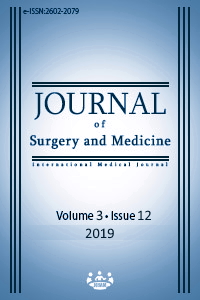Is there any relationship between propofol induction dose and duration of seizure for repetitive electroconvulsive therapies?
Keywords:
Electroconvulsive therapy, Propofol, SeizureAbstract
Aim: Anesthetic agents have been used during electroconvulsive therapy for years, but selecting the agent remains a challenge. Anesthetics may play a negative role on seizure duration, which directly affects the success of the treatment. This study is designed to see the relationship of repetitive sessions, anesthetic dose, and seizure duration.
Methods: A total of 73 ECT treatments for 11 patients were evaluated for this prospective-cohort study. After premedication, propofol was administered slowly until the patient lost eyelash reflex. The duration of the seizure, propofol dose administered, and the time between the end of the procedure and full recovery (as decided by Aldrete score) were recorded.
Results: The mean seizure time was 25.5 (10.2) seconds. There was a statistically significant correlation between seizure duration, the number of sessions and propofol dose, and no correlation between the time to reach an Aldrete score of 10 and both the number of sessions and propofol dosing.
Conclusion: An increased propofol dosage may be needed during ECT as the number of session increases, but this increase does not affect recovery time.
Downloads
References
Fink M, Taylor MA. Electroconvulsive therapy. JAMA. 2007;298(3):330–2.
Steven RJ, Tovel RM, Johnson JC, Delgado E. Anesthesia for electroconvulsive therapy. Anesthesiology. 1954;15(6):623–36.
Wagner KJ, Mollenberg O, Rentrop M, Werner C, Kochs EF. Guide to anesthetic selection for electroconvulsive therapy. CNS Drugs. 2005;19:745–75.
Ding Z, White PF. Anesthesia for electroconvulsive therapy. Anesth Analg. 2002;94:1351–64.
Petrides G, Fink M. The ‘‘half-age’’ stimulation strategy for ECT dosing. Convuls Ther. 1996;12:138–46.
Abrams R. Electroconvulsive Therapy. New York, NY: Oxford University Press; 2002.
An den Broek WW, Leentjens AFG, van Vliet IM, et al. Hand-boek Elektroconvulsietherapie. Assen, the Netherlands: Koninklijke Van Gorkum. 2005.
Rasmussen KG. Propofol for ECT Anesthesia a Review of the Literature. J ECT. 2014;30:210–5.
Van Waarde JA, van Oudheusden LJ, Verwey B, Giltay EJ, van der Mast RC. Clinical predictors of seizure threshold in electroconvulsive therapy: a prospective study. Eur Arch Psychiatry Clin Neurosci. 2013;263:167–75.
Bundy BD, Hewer W, Andres FJ, Gass P, Sartorius A. Influence of anesthetic drugs and concurrent psychiatric medication on seizure adequacy during electroconvulsive therapy. J Clin Psychiatry. 2010 Jun;71(6):775–7.
Janouschek H, Nickl-Jockschat T, Haeck M, Gillmann B, Grözinger M. Comparison of methohexital and etomidate as anesthetic agents for electroconvulsive therapy in affective and psychotic disorders. J Psychiatr Res. 2013;47:686–93.
Yalcin S, Aydogan H, Selek S, Kucuk A, Yuce HH, Karababa F, et al. Ketofol for electroconvulsive therapy anesthesia, two stones for one bird. J Anesth. 2012;26:562–7.
Downloads
- 677 939
Published
Issue
Section
How to Cite
License
Copyright (c) 2019 Çiğdem Yıldırım Güçlü, Ahmet Onat Bermede, Başak Ceyda Meço, Zekeriyya Alanoğlu, Neslihan Alkış
This work is licensed under a Creative Commons Attribution-NonCommercial-NoDerivatives 4.0 International License.
















